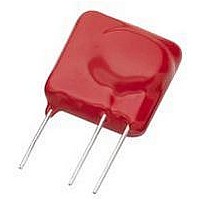TMOV25SP385M Littelfuse Inc, TMOV25SP385M Datasheet - Page 31

TMOV25SP385M
Manufacturer Part Number
TMOV25SP385M
Description
TMOV VARISTOR PB FREE 25S
Manufacturer
Littelfuse Inc
Series
iTMOV®r
Specifications of TMOV25SP385M
Varistor Voltage
682V
Current-surge
20kA
Number Of Circuits
1
Maximum Ac Volts
385VAC
Energy
430J
Package / Case
Disc 25mm 3-Lead
Suppressor Type
Varistor
Peak Surge Current @ 8/20µs
20000A
Varistor Case
25mm DISC
Clamping Voltage Vc Max
1010V
Peak Energy (10/1000us)
430J
Voltage Rating Vdc
682V
Voltage Rating Vac
385V
Lead Free Status / RoHS Status
Lead free / RoHS Compliant
Maximum Dc Volts
-
Lead Free Status / Rohs Status
Lead free / RoHS Compliant
- Current page: 31 of 212
- Download datasheet (7Mb)
Specifications are subject to change without notice.
Please refer to www.littelfuse.com/series/MHS.html for current information.
©2009 Littelfuse, Inc.
Device Characteristics
At low current levels, the V-I curve of the multilayer
transient voltage suppressor approaches a linear (ohmic)
relationship and shows a temperature dependent effect.
At or below the maximum working voltage, the suppressor
is in a high resistance model (approaching 10
maximum rated working voltage). Leakage currents at
maximum rated voltage are below 100μA, typically 25μA;
for 0402 size below 20μA, typically 5μA.
Lead (Pb) Soldering Recommendations
The principal techniques used for the soldering of
components in surface mount technology are IR Re-flow
and Wave soldering. Typical profiles are shown on the right.
The recommended solder for the MHS suppressor is
a 62/36/2 (Sn/Pb/Ag), 60/40 (Sn/Pb) or 63/37 (Sn/Pb).
Littelfuse also recommends an RMA solder flux.
Wave soldering is the most strenuous of the processes.
To avoid the possibility of generating stresses due to
thermal shock, a preheat stage in the soldering process
is recommended, and the peak temperature of the solder
process should be rigidly controlled.
When using a reflow process, care should be taken to
ensure that the MHS chip is not subjected to a thermal
gradient steeper than 4 degrees per second; the ideal
gradient being 2 degrees per second. During the soldering
process, preheating to within 100 degrees of the solder's
peak temperature is essential to minimize thermal shock.
Once the soldering process has been completed, it is
still necessary to ensure that any further thermal shocks
are avoided. One possible cause of thermal shock is hot
printed circuit boards being removed from the solder
process and subjected to cleaning solvents at room
temperature. The boards must be allowed to cool gradually
to less than 50ºC before cleaning.
Figure 5
Typical Temperature Dependance of the Characteristic
100%
10%
1E
-9
1E
-8
25
o
50
Curve in the Leakage Region
o
1E
75
-7
o
SUPPRESSOR CURRENT (A
100
o
1E
125
-6
o
C
1E
-5
DC
1E
)
Varistor Products
-4
Surface Mount Multilayer Varistors (MLVs) > MHS Series
6
Ω at its
1E
-3
1E
Revision: November 5, 2009
-2
27
Speed of Response
The Multilayer Suppressor is a leadless device. Its
response time is not limited by the parasitic lead
inductances found in other surface mount packages.
The response time of the Z
than 1ns and the MLE can clamp very fast dV/dT events
such as ESD. Additionally, in “real world” applications,
the associated circuit wiring is often the greatest
factor effecting speed of response. Therefore, transient
suppressor placement within a circuit can be considered
important in certain instances.
Reflow Solder Profile
Wave Solder Profile
Figure 7
Figure 8
Figure 6
TERMINATION
METAL END
FIRED CERAMIC
Multilayer Internal Construction
DIELECTRIC
DEPLETION
DEPLETION
REGION
REGION
N
O dielectric material is less
230
GRAINS
METAL
ELECTRODES
MHS Varistor Series
Related parts for TMOV25SP385M
Image
Part Number
Description
Manufacturer
Datasheet
Request
R

Part Number:
Description:
FUSEHOLDER 20A MINI INLINE CRIMP
Manufacturer:
Littelfuse Inc
Datasheet:

Part Number:
Description:
FUSEHOLDER BODY ATO INLINE PNLMT
Manufacturer:
Littelfuse Inc
Datasheet:

Part Number:
Description:
FUSE 2A 63V FAST 1206
Manufacturer:
Littelfuse Inc
Datasheet:

Part Number:
Description:
FUSE 1.25A 63V FAST 1206
Manufacturer:
Littelfuse Inc
Datasheet:

Part Number:
Description:
FUSE .250A 125V FAST 1206
Manufacturer:
Littelfuse Inc
Datasheet:

Part Number:
Description:
FUSE 4A 32V FAST 1206
Manufacturer:
Littelfuse Inc
Datasheet:

Part Number:
Description:
FUSE 1.75A 63V FAST 1206
Manufacturer:
Littelfuse Inc
Datasheet:

Part Number:
Description:
FUSE 1A 32V FST 0603 LEADFREE TR
Manufacturer:
Littelfuse Inc
Datasheet:

Part Number:
Description:
FUSE 1A 32V FAST SLIM 0402
Manufacturer:
Littelfuse Inc
Datasheet:

Part Number:
Description:
FUSE 2A 125V FAST NANO2 SMD
Manufacturer:
Littelfuse Inc
Datasheet:

Part Number:
Description:
FUSE .250A 125V FAST NANO2 SMD
Manufacturer:
Littelfuse Inc
Datasheet:

Part Number:
Description:
FUSE .500A 125V FAST NANO2 SMD
Manufacturer:
Littelfuse Inc
Datasheet:

Part Number:
Description:
FUSE 1.5A 125V FAST NANO2 SMD
Manufacturer:
Littelfuse Inc
Datasheet:

Part Number:
Description:
FUSE 4A 125V FAST NANO2 SMD
Manufacturer:
Littelfuse Inc
Datasheet:

Part Number:
Description:
FUSE 1A 125V FAST NANO2 SMD
Manufacturer:
Littelfuse Inc
Datasheet:










